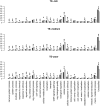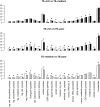The Transposable Element Environment of Human Genes Differs According to Their Duplication Status and Essentiality
- PMID: 33973013
- PMCID: PMC8155550
- DOI: 10.1093/gbe/evab062
The Transposable Element Environment of Human Genes Differs According to Their Duplication Status and Essentiality
Erratum in
-
Erratum to: The Transposable Element Environment of Human Genes Differs According to Their Duplication Status and Essentiality.Genome Biol Evol. 2021 Sep 1;13(9):evab175. doi: 10.1093/gbe/evab175. Genome Biol Evol. 2021. PMID: 34508264 Free PMC article. No abstract available.
Abstract
Transposable elements (TEs) are major components of eukaryotic genomes and represent approximately 45% of the human genome. TEs can be important sources of novelty in genomes and there is increasing evidence that TEs contribute to the evolution of gene regulation in mammals. Gene duplication is an evolutionary mechanism that also provides new genetic material and opportunities to acquire new functions. To investigate how duplicated genes are maintained in genomes, here, we explored the TE environment of duplicated and singleton genes. We found that singleton genes have more short-interspersed nuclear elements and DNA transposons in their vicinity than duplicated genes, whereas long-interspersed nuclear elements and long-terminal repeat retrotransposons have accumulated more near duplicated genes. We also discovered that this result is highly associated with the degree of essentiality of the genes with an unexpected accumulation of short-interspersed nuclear elements and DNA transposons around the more-essential genes. Our results underline the importance of taking into account the TE environment of genes to better understand how duplicated genes are maintained in genomes.
Keywords: LINE; SINE; essential genes; gene duplication; gene evolution; transposable elements.
© The Author(s) 2021. Published by Oxford University Press on behalf of the Society for Molecular Biology and Evolution.
Figures





Similar articles
-
Comparative analysis of transposable elements highlights mobilome diversity and evolution in vertebrates.Genome Biol Evol. 2015 Jan 9;7(2):567-80. doi: 10.1093/gbe/evv005. Genome Biol Evol. 2015. PMID: 25577199 Free PMC article.
-
Comparative analysis of transposable elements provides insights into genome evolution in the genus Camelus.BMC Genomics. 2021 Nov 20;22(1):842. doi: 10.1186/s12864-021-08117-9. BMC Genomics. 2021. PMID: 34800971 Free PMC article.
-
Identification, characterization and distribution of transposable elements in the flax (Linum usitatissimum L.) genome.BMC Genomics. 2012 Nov 21;13:644. doi: 10.1186/1471-2164-13-644. BMC Genomics. 2012. PMID: 23171245 Free PMC article.
-
Mammalian transposable elements and their impacts on genome evolution.Chromosome Res. 2018 Mar;26(1-2):25-43. doi: 10.1007/s10577-017-9570-z. Epub 2018 Feb 1. Chromosome Res. 2018. PMID: 29392473 Free PMC article. Review.
-
Transposable elements as genetic accelerators of evolution: contribution to genome size, gene regulatory network rewiring and morphological innovation.Genes Genet Syst. 2020 Jan 30;94(6):269-281. doi: 10.1266/ggs.19-00029. Epub 2020 Jan 10. Genes Genet Syst. 2020. PMID: 31932541 Review.
Cited by
-
Characterization of transposable elements within the Bemisia tabaci species complex.Mob DNA. 2022 Apr 19;13(1):12. doi: 10.1186/s13100-022-00270-6. Mob DNA. 2022. PMID: 35440097 Free PMC article.
-
Insights into the Evolution of Ohnologous Sequences and Their Epigenetic Marks Post-WGD in Malus Domestica.Genome Biol Evol. 2023 Oct 6;15(10):evad178. doi: 10.1093/gbe/evad178. Genome Biol Evol. 2023. PMID: 37847638 Free PMC article.
-
Universal signatures of transposable element compartmentalization across eukaryotic genomes.bioRxiv [Preprint]. 2024 Mar 27:2023.10.17.562820. doi: 10.1101/2023.10.17.562820. bioRxiv. 2024. PMID: 38585780 Free PMC article. Preprint.
References
MeSH terms
Substances
LinkOut - more resources
Full Text Sources
Other Literature Sources

